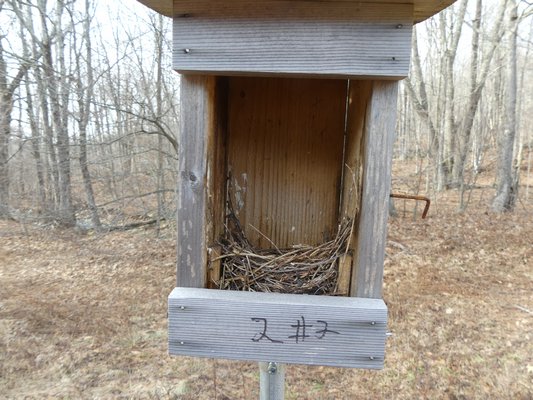

The calendar is telling me that we have just about four weeks until the first day of spring—and, boy, are we ready! It’s been cold, wet and dreary, with January days near zero and February days when it seems like every squirrel on earth was out checking every single spot for that last but not forgotten buried acorn.
I went to check and clean the bluebird nesting boxes, so they’d be inviting for this year’s occupants, and was very pleased to find that every box had been used, with six tree swallow nests and two bluebird nests.
One box even had some winter tenants. As I opened the box, what should have been about 3 inches of nesting material was more like 8 inches, with the top a soft pillowy cushion of feathery seed heads. A poke and a probe, and a white-footed mouse peeks out at me, then another, and another. In all, there were six of them—and they were very reluctant to vacate.
It’s pretty amazing what they brought up the 7-foot steel pipe to make their nests with. But it was time to hit the tundra, as, one by one, they jumped out this way and that to scatter below into the field.
During the deepest, darkest days of winter, it was summer at a window in our dining room. A couple of years ago, neighbor Nancy wandered over from her home next door with a large clay pot occupied by a spindly and sickly begonia. She stopped in the front lawn, looked up at me as I rocked on my porch, and said, “Andrew, you have to take this!” She obviously thought I was a sucker and, because of my plant preoccupation, would welcome her gift.
Nancy was in the early stages of renovating her home, and she thought that while the three-month renovation was taking place I would be happy to plant-sit.
I wasn’t. I know all too well that many a friendship has been doomed by plant-sitting and the unintended results and consequences.
The begonia had chocolatey brown leaves that I’m sure some more articulate onlooker would describe as bronze. It had spindly stems that made me think it had been growing in far too much shade—and it was … oh, let’s just say … ugly.
But Nancy is not a person who can give up on anything that has an atom of life left in it, and she prevailed. She is the neighbor who saves every single baby bird that falls from its nest, every homeless kitten, and she would never set a mousetrap in her home or purge an attic squirrel in the dead of winter.
So, we brought the heavy 14-inch bulb pot with begonia into the dining room and placed it near a window, where it would get some late daylight. All this with the understanding that it would only be for three months, four tops.
Well, this ugly begonia certainly has grown on me, and in more ways than one.
Honestly, I had never grown a begonia before, and while I find some of them to have exquisite foliage, this one was not one I was going to admire.
Now, two years later, it still has those very plain and uninspiring chocolatey bronze leaves. But where there were once maybe 15 of them, there are now 50, and the spindly plant that showed more soil than vegetation now fills the pot, and the plant simply thrives.
So, at this point, you probably think I have special tricks, like secret fertilizers and special potions and secret whispers that I give this begonia. I don’t! In fact, I pretty much ignore it. I water it once a week—something I always tell you not to do. I’ve never given it so much as a grain of fertilizer. And I haven’t even give him/her a name.
Every Sunday, after I give it some water, I give it a quarter turn and remove the leaves that have begun to fade and brown, as it’s always producing new ones. We rarely spend more than two or three days in the house, and when we’re not there the temperature goes down to 50 degrees. The begonia still thrives.
In early January, the plant began to flower. And flower—and flower some more. In fact, it’s still flowering.
The flowers are tiny and as uninspiring as the plant, but if you carefully observe them, you can see that they do indeed resemble, in some way, the begonia flowers of the Rex and waxes that we might have in our gardens. The blooms are atop spindly stems that reach up a foot or more above the plant—and they just keep on coming.
Now, remember, I’ve done nothing to encourage this plant, other than water it once a week and give it a quarter turn once a week. And then it struck me: What a remarkable plant this was! And it became a remarkable learning moment.
As the plant bloomed in the dead of winter, I thought it quite strange, until my classes in plant genetics from decades ago suddenly kicked in. The begonia was blooming in January because its genes were still telling it that whereever its ancestors came from, long, long ago, it was really July and not January. The plant was simply expressing its genetic history and telling me that “home” was someplace where there were only a few hours of good light for growing, where it got pretty cold at night, and where summer was January and not July.
It also was telling me that in our January—its July—it was time to flower and take advantage of the insects, birds and possibly small mammals that would visit its flowers, to feed on the pollen that these pollinators would move to other flowers on the plant, plants nearby, and possibly far away, where cross-pollination would take place and new begonias (with fairly unattractive foliage of a bronzy chocolate color and spindly flower spikes with uninspiring blooms) would lead to the seeds of the next generation of this species of begonia, somewhere in the world’s Southern Hemisphere.
So, a plant that almost got trashed and would have never been missed (except by Nancy) turned out to be quite a lesson of life and a joy to behold in an otherwise dull and drab winter, which I’m happy will end in just about four weeks.
Nancy doesn’t stand a chance of getting it back.
Keep growing!
 More Posts from Andrew Messinger
More Posts from Andrew Messinger